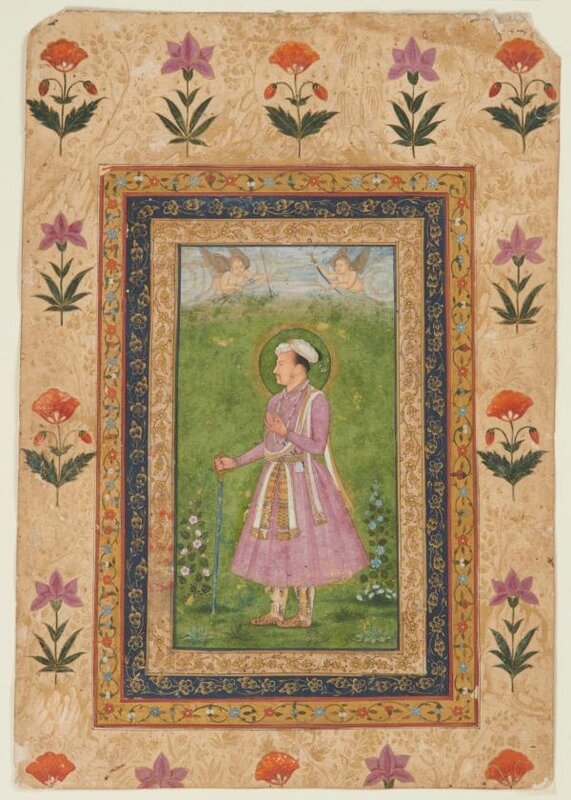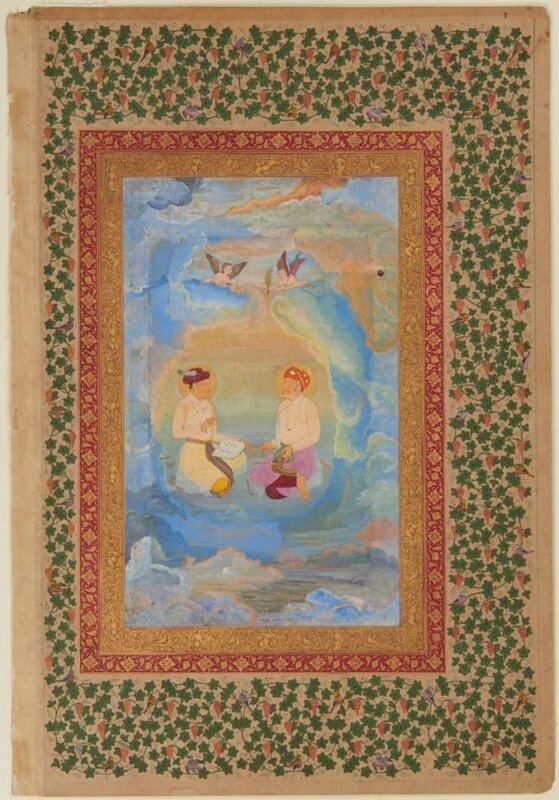The J. Paul Getty Museum presents "Rembrandt and the Inspiration of India"
LOS ANGELES.- Among the most surprising aspects of Rembrandt’s prodigious output are twenty-three surviving drawings closely based on portraits made by artists working in Mughal India. These drawings mark a striking diversion for this quintessentially Dutch “Golden Age” artist, the only time he made a careful and extensive study of art from a dramatically different culture. Rembrandt and the Inspiration of India, on view March 13 –June 24, 2018, at the J. Paul Getty Museum at the Getty Center, explores for the first time the artist’s Mughal drawings, exhibiting them alongside the Mughal paintings that inspired them to assess the impact of Indian art and culture on Rembrandt’s artistic interests and working process as a draftsman.
“Rembrandt may be one of the most famous painters in European art history, but there are still remarkable discoveries to be made about his work,” says Timothy Potts, director of the J. Paul Getty Museum. “This exhibition is a case in point, demonstrating how Rembrandt turned to the art of India to produce some of his most intriguing images. This vivid example of cultural exchange reminds us how artists on different continents take inspiration from one another, a reality that of course continues to this very day."
Rembrandt Harmensz. van Rijn (Dutch, 1606–1669), Shah Jahan and Dara Shikoh, ca. 1656–61. Brown ink and brown wash with white opaque watercolor and scratching out on Asian paper toned with light brown wash, 21.3 x 17.8 cm (8 3/8 x 7 in.). The J. Paul Getty Museum, Los Angeles 85.GA.44
The exhibition pairs twenty of Rembrandt’s surviving drawings depicting Mughal emperors, princes, and courtiers with Indian paintings and drawings of similar compositions, which had been brought to Amsterdam from the Dutch trading post in Surat. Rembrandt’s portraits reveal how his contact with Mughal art inspired him to draw in a newly refined and precise style.
“The critical eye and attentive curiosity Rembrandt turned towards Mughal portrait conventions still captivates viewers today. At this late stage in his career, around 1656-1661, this meticulous rendering is exceptional,” says Stephanie Schrader, Curator of Drawings and organizer of the exhibition.
Rembrandt Harmensz. van Rijn (Dutch, 1606–1669), Indian Ruler (Shah Shuja‘), ca. 1656–61. Brown ink and brown wash on Asian paper toned with light brown wash, 23 × 18 cm (91⁄16 × 71⁄8 in.), Vienna, Albertina Museum, 24471 www.albertina.at EX.2018.3.1
Rembrandt and the Inspiration of India also examines how global trade and cultural exchange impacted artists working for Mughal emperors in India, who were in turn inspired by Dutch and Flemish printed images of European rulers and scenes of daily life. Among the treasures found in a Dutch East India ship, which sank en route to China, was a package that contained four hundred prints by and after Dutch and Flemish artists. This astounding quantity suggests that Dutch merchants thought that art would help them gain access to the Asian market in the sixteenth and seventeenth centuries. These prints were particularly interesting to Mughal court artists, who were already accustomed to working with single-tone drawings and calligraphy. Rather than copy the European compositions exactly, Mughal artists adapted them to their own artistic purposes, as seen in Keshav Das’s Roman Hero (about 1590-95), based on prints by the Dutch artist Hendrick Goltzius. The use of these prints illuminates the range of images that found a positive reception in India long before Rembrandt made his creative copies.
The Mughal Emperor Shah Jahan (r. 1627-1658) was well known for his patronage of the arts — most notably the building of the Taj Mahal. Shah Jahan’s rule of Mughal India spanned the years that Rembrandt worked in Leiden and Amsterdam. In his eight drawings of Shah Jahan, more than he made of any other Mughal ruler, Rembrandt carefully studied the trappings of imperial magnificence, as seen in on Horseback (Shah Jahan) (about 1656-61). The poetic claim that Shah Jahan was “Royal Rider of the Piebald Steed of the World” was not lost on Rembrandt.
Rembrandt Harmensz. van Rijn (Dutch, 1606–1669), Four Mullahs Seated under a Tree (Sheikh Husain Jami, Sheikh Husain Ajmeri, Sheikh Muhammad Mazandarani, and Sheikh Miyan Mir), ca. 1656–61. Brown ink and brown and gray wash with scratching out on Asian paper toned with light brown wash, 19.4 × 12.4 cm (75⁄8 × 47⁄8 in.) London, The British Museum, 1895,0915.1275. Image © The Trustees of the British Museum. All rights reserved EX.2018.3.5
Rembrandt’s drawings after Mughal compositions constitute the largest group, by far, of his copies after other works of art. Moreover, they are his only surviving drawings on expensive Asian paper, which suggests the high value the artist himself placed on them. Shikoh (about 1656-60) is quite different from the typically known “late Rembrandt” style of drawing. His careful attention to details of clothing, jewelry, turbans, and footwear pays tribute to Mughal artists’ exceptional artifice.
On almost every level, Rembrandt and the Indian court painters operated in completely different worlds. Yet such differences did not prevent these innovative artists from appropriating foreign imagery to reflect upon and enrich their own more familiar artistic practice and culture.
Rembrandt and the Inspiration of India is curated by Stephanie Schrader, curator in the Department of Drawings. The exhibition is on view at the J. Paul Getty Museum at the Getty Center from March 13 –June 24, 2018.
Rembrandt Harmensz. van Rijn (Dutch, 1606–1669), A Mughal Nobleman Standing (Prince Daniyal), ca. 1656–61. Brown ink and brown wash with red chalk and white opaque watercolor on Asian paper, 18.4 × 11.2 cm (7¼ × 47⁄16 in.), London, The British Museum, Bequeathed by George Salting, 1910,0212.182. Image © The Trustees of the British Museum. All rights reserved EX.2018.3.7.
Rembrandt Harmensz. van Rijn (Dutch, 1606–1669), A Deccani Nobleman Standing (Muhammad ‘Adil Shah of Bijapur), ca. 1656–61. Brown ink and brown and gray wash with scratching out on Asian paper toned with light brown wash, 19.6 × 15.8 cm (711⁄16 × 6¼ in.), London, The British Museum, 1895,0915.1280. Image © The Trustees of the British Museum. All rights reserved EX.2018.3.8.
Rembrandt Harmensz. van Rijn (Dutch, 1606–1669), Two Mughal Noblemen (Shah Jahan and Dara Shikoh), ca. 1656–61. Brown ink and brown and gray wash with white opaque watercolor and scratching out on Asian paper toned with light brown wash, 17.2 × 21.4 cm (6 3/4 × 8 7⁄16 in.), London, The British Museum, 1895,0915.1281. Image © The Trustees of the British Museum. All rights reserved EX.2018.3.9.
Rembrandt Harmensz. van Rijn (Dutch, 1606–1669), A Mughal Nobleman on Horseback (Shah Jahan), ca. 1656–61. Brown ink and brown and gray wash with red chalk wash and red and yellow chalk lightly toned with light brown wash on Asian paper, 20.5 × 17.7 cm (8 1⁄16 × 6 15⁄16 in.), London, The British Museum, Bequeathed by Clayton Mordaunt Cracherode, PD Gg,2.262. Image © The Trustees of the British Museum. All rights reserved EX.2018.3.10.
Muhammad Mushin, Indian (Mughal), Jahangir, ca. 1630–35. Opaque watercolor and gold on paper. Painting: 31.1 × 21 cm (12 1/4 × 8 1/4 in.). Private Collection, EX.2018.3.15.
Attributed to Bichitr Indian (Mughal), active 1615–50. Folio from the St. Petersburg Album, Akbar and Jahangir in Apotheosis, ca. 1640. Opaque watercolor, ink, and gold on paper. Page: 48.4 × 33 cm (19 1/16 × 13 in.); painting: 27.5 × 16.8 cm (10 13/16 × 6 5/8 in.), Private Collection, EX.2018.3.16.
Rembrandt Harmensz. van Rijn (Dutch, 1606–1669), Shah Jahan, Standing with a Flower and a Sword, ca. 1656–61. Brown ink with brown wash on Asian paper with horizontal strip added along bottom edge, 17.8 × 10.1 cm (7 × 4 in.). Paris, Fondation Custodia, Collection Frits Lugt, 592 EX.2018.3.21.
Unknown Indian (Mughal) artist, after an engraving by Simon van de Passe (Dutch, 1596–1647), Portrait of Queen Anne of Denmark, first half of the seventeenth century. Ink on paper, 25 × 18.5 cm (9 13/16 × 7 5/16 in.), Paris, Musée national des Arts Asiatiques–Guimet, MA 2646. Image © RMN-Grand Palais / Art Resource, NY. Photo: Thierry Ollivier EX.2018.3.25.
Bichitr Indian (Mughal), active 1615–50. Folio from Minto Album, Jujhar Singh Bundela Kneels in Submission to Shah Jahan, ca. 1630–40. Opaque watercolor and gold on paper. Page: 39 × 27 cm (15 3/8 × 10 5/8 in.); painting: 26.4 × 16.2 cm (10 3/8 × 6 3/8 in.), Dublin, Trustees of the Chester Beatty Library, CBL In 07A.16. Image © Trustees of the Chester Beatty Library, Dublin (CBL In 07A.16) EX.2018.3.29.
Unknown Indian (Deccani) artist, Portrait of Muhammad ‘Adil Shah of Bijapur, ca. 1685. Opaque watercolor and gold on paper. Page: 12 × 9.4 cm (4 3/4 × 3 11/16 in.), Amsterdam, Rijksmuseum, RP-T-1995-25 EX.2018.3.34.
Rembrandt Harmensz. van Rijn (Dutch, 1606–1669), An Indian Archer, ca. 1656–61. Brown ink and brown and gray washes with red wash, white opaque watercolor, and scratching out on Asian paper toned with light brown wash, 18.8 × 13.1 cm (7 3/8 × 5 3/16 in.) Amsterdam, Rijksmuseum, RP-T-1897-A-3203 EX.2018.3.35.
Rembrandt Harmensz. van Rijn (Dutch, 1606–1669), Jahangir, ca. 1656–61. Brown ink and brown, gray, and red washes with scratching out on Asian paper toned with light brown wash, 18.3 × 12 cm (7 3/16 × 4 3/4 in.), Amsterdam, Rijksmuseum, De Bruijn-van der Leeuw Bequest, Muri, Switzerland, RP-T-1961-82 EX.2018.3.36.
Rembrandt Harmensz. van Rijn (Dutch, 1606–1669), Shah Jahan and His Son, ca. 1656–61; Brown ink and brown wash with scratching out on Asian paper toned with light brown wash, 6.9 × 7.1 cm (2 11/16 × 2 13/16 in.), Amsterdam, Rijksmuseum, Gift of J. G. Bruijnvan der Leeuw, Muri, RP-T-1961-83 EX.2018.3.38
Rembrandt Harmensz. van Rijn (Dutch, 1606–1669), The Emperor Akbar and Jahangir in Apotheosis, after a Mughal Miniature, ca. 1656–61 Brown ink with brown wash with white opaque watercolor and scratching out on Asian paper toned with light brown wash 21.2 × 17.6 cm (8 3/8 × 6 15/16 in.) Rotterdam, Museum Boijmans van Beuningen (former collection Koenigs), R 36 (PK). Photo: Studio Tromp, Rotterdam EX.2018.3.39.
Rembrandt Harmensz. van Rijn (Dutch, 1606–1669), Shah Jahan, ca. 1656–61. Dark brown ink and dark brown wash with scratching out on Asian paper toned with light brown wash, 22.5 × 17.1 cm (8 7/8 × 6 3/4 in.), Cleveland, The Cleveland Museum of Art, Leonard C. Hanna Jr. Fund, 1978.38. Image © The Cleveland Museum of Art EX.2018.3.41.
Govardhan Indian (Mughal), active 1596–ca. 1645, Shah Jahan Enthroned with His Son Dara Shikoh, ca. 1630–40. Opaque watercolor and gold on paper. Page: 47.8 × 34.2 cm (18 13/16 × 13 1/2 in.); painting: 29 × 19.8 cm (11 7/16 × 7 13/16 in.). San Diego, The San Diego Museum of Art, Edwin Binney 3rd Collection, 1990.347. Image: San Diego Museum of Art, USA / Bridgeman Images EX.2018.3.50.
Rembrandt Harmensz. van Rijn (Dutch, 1606–1669), Portrait of Aurangzeb (after a Mughal painting), ca. 1656–61. Brown ink with brown wash, black chalk, white opaque watercolor, and scratching out on Asian paper; with later additions in gray wash and scratching out, 18 × 7.3 cm (7 1/16 × 2 7/8 in.), Cambridge, Harvard Art Museums / Fogg Museum, Bequest of Charles A. Loeser, 1932.366. Imaging Department © President and Fellows of Harvard College EX.2018.3.55.
Unknown artist, after Adriaen Brouwer (Flemish, 1605/6–1638), Pancake Woman, 1650–80. Engraving State ii/ii published by Frederick de Wit (ca. 1630–1706). Diameter: 18.1 cm (7 1⁄8 in.), London, The British Museum, S.6265. Image © The Trustees of the British Museum. All rights reserved EX.2018.3.12.
Unknown Indian (Mughal) artist, after an engraving made after Adriaen Brouwer (Flemish, 1605/6–1638), Pancake Woman, ca. 1640–80. Opaque watercolor with gold on paper. Painting: 16.4 × 19.2 cm (6 1/2 × 7 9/16 in.), Fiona Chalom and Joel Aronowitz EX.2018.3.44.

/https%3A%2F%2Fprofilepics.canalblog.com%2Fprofilepics%2F1%2F0%2F100183.jpg)
/https%3A%2F%2Fstorage.canalblog.com%2F03%2F02%2F119589%2F96711876_o.jpg)
/https%3A%2F%2Fstorage.canalblog.com%2F11%2F31%2F119589%2F94773502_o.jpg)
/https%3A%2F%2Fstorage.canalblog.com%2F20%2F83%2F119589%2F94772815_o.jpg)
/https%3A%2F%2Fstorage.canalblog.com%2F26%2F72%2F119589%2F75604929_o.jpg)
/https%3A%2F%2Fstorage.canalblog.com%2F59%2F60%2F119589%2F26458628_o.jpg)

























/http%3A%2F%2Fstorage.canalblog.com%2F29%2F54%2F119589%2F115226649_o.jpg)
/http%3A%2F%2Fstorage.canalblog.com%2F91%2F45%2F119589%2F129453113_o.jpg)
/http%3A%2F%2Fstorage.canalblog.com%2F10%2F81%2F119589%2F127170196_o.jpg)
/http%3A%2F%2Fstorage.canalblog.com%2F76%2F90%2F119589%2F121087488_o.jpg)